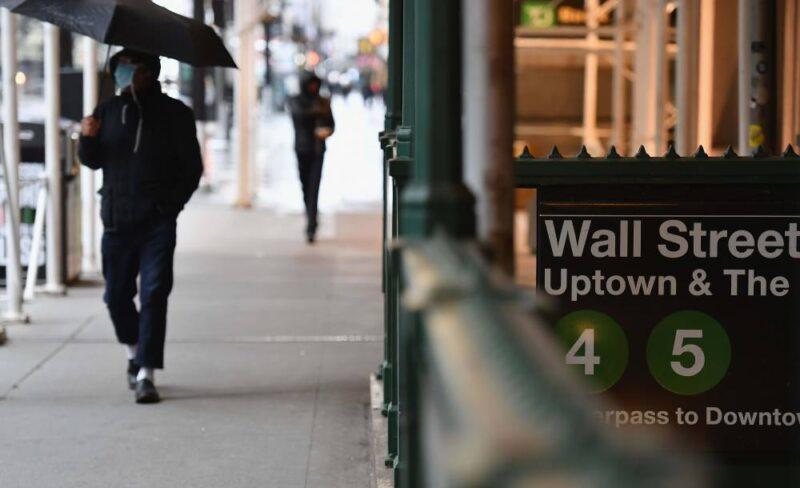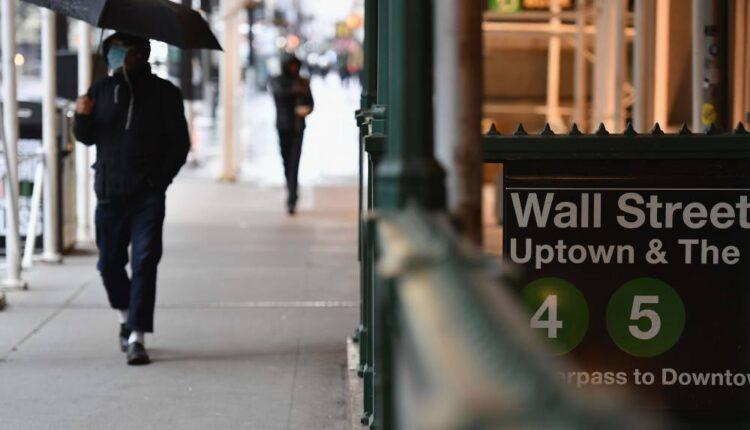
- The quarterly and monthly rebalancing of portfolios is expected by some traders to create a big move into stocks and out of bonds by the end of Tuesday.
- Forecasts of how much pension funds could buy in stocks before the end this terrible quarter have been estimated in a wild range by Wall Street, from about $20 billion to over $200 billion.
- Several strategists expect the buying to be at the lower end of the range and say some of the trading may already have happened, raising concerns about what could happen when the new month begins Wednesday.
A man walks by the Wall Street subway sign on March 23, 2020 in New York City.Angela Weiss | AFP | Getty Images
Some traders are looking for a surge in stock buying on Tuesday as fund managers rebuild their stock holdings in the final hours of the worst quarter for the Dow since 1987.
That's because as stocks lost ground, pension funds' allocation to equities shrank, and as bonds rallied, those assets in their portfolios increased. In addition to pensions, other funds and investors may also see the need to conduct a rebalancing to shift the mix back by Tuesday's closing bell, the end of the month and the first quarter.
VIDEO6:1706:17Eaton Vance chief investment officer says fund rebalancing is driving the market upwardPRO Uncut
That simply means they could sell bonds and buy stocks.
"The rebalancing story is something everybody is watching very closely. It might help temporarily prop up some asset prices, either directly or via the expectations it might happen," said Jon Hill, senior BMO rate strategist. "The question is what happens April 1? I think this is a second order factor, but everybody is trying to rebalance everything they're doing. I'm not sure that leads to a huge flood into equities just because of the state of market uncertainty."
The Dow is down 21.8% this quarter, the worst since the 25% decline in the fourth quarter of 1987 and the worst Q1 ever. The S&P 500 is on pace for an 18% decline, its worst quarter since the fourth quarter of 2008 and its worst first quarter since 1938.
"We think there's an element of people positioning themselves for a big buy," said Julian Emanuel, chief equities and derivatives strategist at BTIG. Emanuel said the forecasts for how much funds might buy range wildly from $20 billion to over $200 billion, and he blames those expectations for some of the market volatility.
"The best, ideal scenario … would be for nothing to happen in markets," Emanuel said, adding the market needs some less volatile sessions. "Everybody's on a hamster's wheel in light of the rally last Tuesday, Wednesday and Thursday. What you really need is a couple of days for both buyers and sellers to catch their breath. … What you need is several days of calm so people can reassess instead of this utterly frantic feeling to the downside and the upside. Coming out of the pension rebalancing is a very good time."
Did the rebalance already happen?
Futures turned lower in early morning trading.
Emanuel said the buying may in fact have already been happening. "In theory, they say that kind of thing is supposed to happen at the close tomorrow but in practice it very rarely turns out that way," he said Monday. "Our mantra has been to buy weakness. Do not chase strength. Could you get a retest of the lows in the next few weeks? You absolutely could."
VIDEO4:5504:55Leuthold's Paulsen: Markets could start recovering before coronavirus crisis endsSquawk Box
Michael Schumacher, director of rates at Wells Fargo, said his team initially forecast $40 billion in outflows from stocks, but with the rally over the past week, the rebalancing looks to be more like $20 billion out of stocks and into bonds. The S&P 500 is up 7% in the last five days.
"We look at the total gap between where we think pensions are today, and what their target is," he said. "We calculate that's at $80 billion, and we assume at quarter-end the rebalance is about a quarter of it — that gives us $20 billion. In rough numbers, call it 50 to 55% in equities and 35 to 40% in high quality bonds."
Schumacher said the weakness in Treasurys signaled some selling Monday, but it was not clear if it was due to rebalancing.
Source: cnbc.com

